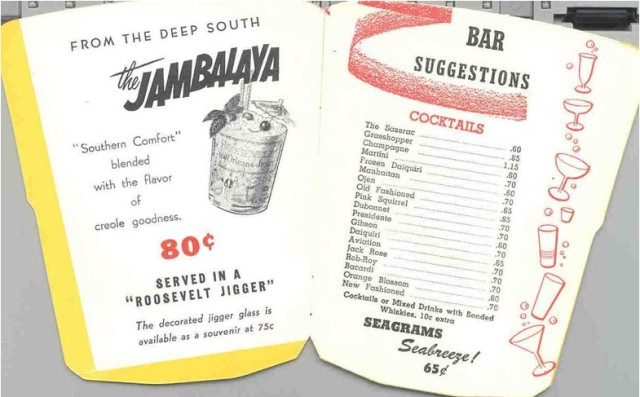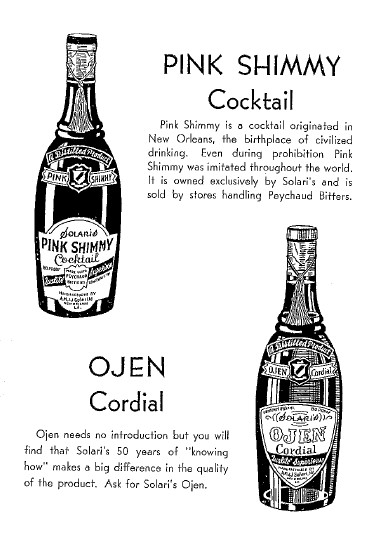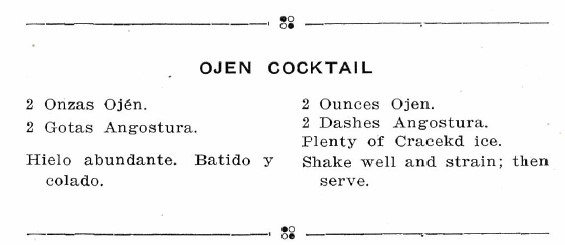Ojen Special
1 ½ oz Ojen
2-3 dashes Peychaud’s Bitters
1 teaspoon sugar or dash simple syrup
2-3 oz seltzer water
Add all ingredients to a mixing glass filled with ice. Stir well, strain into chilled cocktail glass.
Suggested Reading: To Have and Have Not (Chapters XXI and XXII)
Often referred to as “Spanish Absinthe,” Ojen is a slightly sweeter style of anisette, the anise flavored liqueur. In fact, as it does not have wormwood, it is not a true Absinthe. It originated in the southern Spanish town of Ojen, in Andalucia, just up the coast from Gibraltar. Ojen (pronounced oh-hen) originated in the 19th Century, a proprietary product made by the Morales family. Production came to a halt when the last male Morales died; he took the recipe with him to his grave, so to speak. Fortunately, the Manuel Fernandez company of Jerez developed their own recipe, and production resumed for many decades. By the 1980s, however, with sales sagging, the Fernandez family decided to pack it in, and until recently, Ojen was very hard to come by.
Until recently, you see, the Sazerac Company has released its own version of Ojen, and it’s really nice. Go find some and read on!

Until this new offering, your best shot at finding it might have been in New Orleans. You see, the Crescent City historically has had a taste for anise-flavored drinks (think black licorice), including Absinthe, Herbsaint, Green Opal, and Ojen. In fact, the Ojen Cocktail was one of the official cocktails of Mardi Gras, particularly for the Krewe of Rex, and Orleanians are said to consume more Ojen than another city on earth. For many years, Ojen-based drinks have been a staple on the menus of Antoine’s, Galatoire’s and Brennan’s (where the Ojen Frappe is said to be made with “the absinthe of the Spanish aristocracy”). So, when the Fernandez family announced it was ceasing production, Martin Wine Cellar (on Magazine Street, one of the author’s favorite stores) ordered some 500 cases. Apparently the last of the Manuel Fernandez White Label Ojen was sold by Martin around 2009, though you might be able to find a spare bottle or two at auction, or tucked away in someone’s sideboard.

Vintage Ojen Cocktail ad from New Orleans, courtesy of Jay Hendrickson
Until the Sazerac Company’s resurrection of Ojen, Orleanians with a taste for Ojen have embraced another one of Hemingway’s preferred anisette’s, that being Anis del Mono, made by Vincente Bosch (and also covered in this book). Indeed, in his 1937 book Famous New Orleans Drinks and How to Mix ‘Em, Stanley Clisby Arthur refers to Anis del Mono as being among the “old and odd names for Ojen in New Orleans.” It’s not exactly the same, but it’s a worthy substitute.

Back in the 1950s, at the Roosevelt Hotel in New Orleans, you could score an Ojen Cocktail for 70 cents!!


Famous New Orleans Drinks and How to Mix ‘Em, published the same year as To Have and Have Not, and containing the Ojen Cocktail. From the collection of the author. Pink Shimmy and Ojen Cordial ads, courtesy the Sazerac Co., New Orleans.

Even closer to Key West than New Orleans, we see the Ojen Cocktail in Havana, on the Floridita’s 1937 menu, from the author’s collection.
From the 1937 novel To Have and Have Not, we have the Ojen Special, which I’m guessing is the Ojen Cocktail, a simple cocktail made with Ojen, Peychaud’s Bitters, sugar (optional), and seltzer water. In a 1933 letter to his wife Pauline, Hemingway speaks of having “ojen wine and siphon,” referring to the method of dispensing the charged water. The Ojen Special appears in Chapter XXII, but you really have to read the preceding chapter for context. Remember, the novel centers around the haves and have-nots in 1930s Key West, the working-class Conchs barely scraping by in what Hemingway called “the Saint Tropez of the Poor,” and those more fortunate, at least, financially. By the mid-Thirties, Key West marketing itself as a tourist mecca, going so far as to put Hemingway’s house on sightseeing maps, much to his dismay. The completion of the Overseas Highway brought an infusion of visitors to the island, and was part of the reason Hemingway gravitated to Cuba, to get away from the people, the noises and distractions.
In Chapter XXI of To Have and Have Not, we find author Richard Gordon having an argument with his wife, who is ready to leave him. She’s aware that Gordon is having a fling with Helene Bradley, who “collected writers as well as their books but Richard Gordon did not know this yet,” while Gordon’s wife is contemplating an affair with Professor MacWalsey, another academic. She’s “tried to be a good wife,” but has grown tired of Gordon’s “cackling,” his “’Look what I’ve done. Look how I’ve made you happy.’” She feels cheated that they could never afford to have children, though they “could afford to go to the Cap d’Antibes to swim and to Switzerland to ski.” She’s aware that Gordon is having a fling with “this Bradley woman” and views it to be “the last straw.” She tells Gordon that she’d even consider marrying Professor MacWalsey; he’d proposed to her that very afternoon. Gordon is crushed, “a hollow had come in him where his heart had been.”
No, it hadn’t been such a great day for Richard Gordon, all told. That very afternoon, he’d been making love to Helene Bradley when her husband, Tommy, walked in. Tommy was apparently used to this sort of thing, and he retreated. But the interruption was too much for Gordon to overcome. “’Don’t mind him. Don’t mind anything. Don’t you see you can’t stop now?’ the woman had said in desperate urgency.” But for Gordon it was too late. “’So that’s the kind of man you are,’ she had said to him. ‘I thought you were a man of the world. Get out of here.’” And that’s how Richard Gordon’s day had gone.
So in Chapter XXII, Gordon is drowning his sorrows. He finds his way to “Conch Town, where all was starched, well-shuttered, virtue, failure, grits and boiled grunts…” He makes his way to a dive bar and gambling joint called the Lilac Time. He’s greeted by the owner, who knows him well.
“’Allo, ‘Allo Mist Gordon. What you have?”
“I don’t know,” said Richard Gordon.
“You don’t look good. Whatsa matter? You don’t feel good?”
“No.”
“I fix you something just fine. Fix you up hokay. You ever try a Spanish absinthe, ojen?”
“Go ahead,” said Gordon.
“You drink him you feel good. Want to fight anybody in a house,” said the proprietor. “Make Mistah Gordon a ojen special.”
Standing at the bar, Richard Gordon drank three ojen specials but he felt no better; the opaque, sweetish, cold, licorice-tasting drink did not make him feel any different.
“Give me something else,” he said to the bartender.
“Whatsa matter? You no like ojen special?” the proprietor asked. “You no feel good?”
“No.”
“You got be careful what you drink after him”
“Give me a straight whiskey.”
The whiskey warmed his tongue and the back of his throat, but it not change his ideas any, and suddenly, looking at himself in the mirror behind the bar, he knew that drinking was never going to do any good to him now. Whatever he had now he had, and it was from now on, and if he drank himself unconscious when he woke up it would be there.
The characters of Richard Gordon and Helene Bradley are said to have been based in part on John Dos Passos and Jane Mason (though it’s not believed that they ever had an affair). Although Hemingway and Dos Passos were close friends from the time they met in World War I Italy (both having served in the ambulance corps), through the mid-Thirties, they’d become estranged over Dos Passos’ position on the Communist Party’s role in the Spanish Civil War. So, Hemingway saw fit to lampoon him not only in this novel, but also in the posthumously-published A Moveable Feast, where Hemingway referred to him as a “pilot fish.”
As a final comment on the Ojen Cocktail, note that the bartender cautions Gordon to “be careful what you drink after him.” Indeed, in Spain there is an old expression, “una copita de ojen,” perhaps a caution to only have one cup of Ojen. Cheers.
